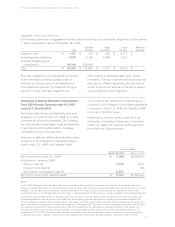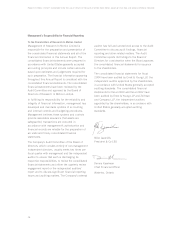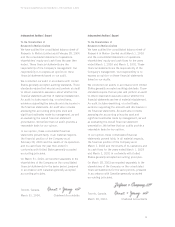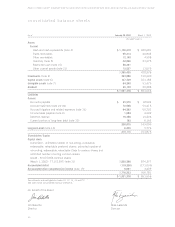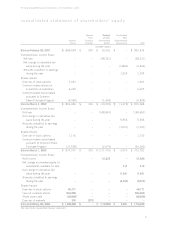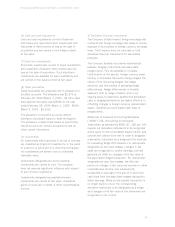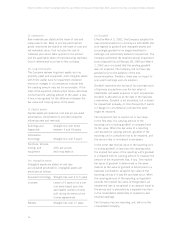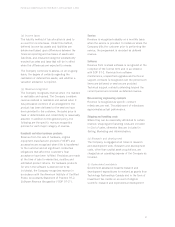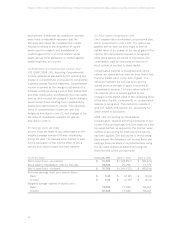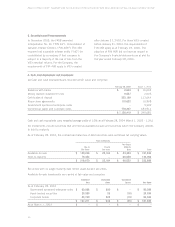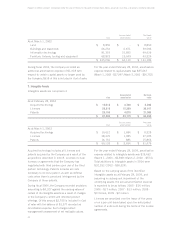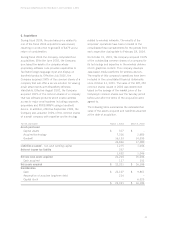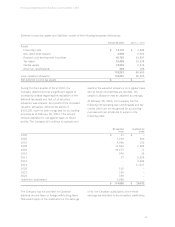Blackberry 2004 Annual Report Download - page 37
Download and view the complete annual report
Please find page 37 of the 2004 Blackberry annual report below. You can navigate through the pages in the report by either clicking on the pages listed below, or by using the keyword search tool below to find specific information within the annual report.
35
For the years ended February 28, 2004, March 1, 2003 and March 2, 2002
(e) Cash and cash equivalents
Cash and cash equivalents consist of balances
with banks and liquid short-term investments with
maturities of three months or less at the date of
acquisition and are carried on the balance sheet
at fair value.
(f) Short-term investments
Short-term investments consist of liquid investments
with maturities of between three months and one
year at the date of acquisition. Such short-term
investments are available for sale investments and
are carried on the balance sheet at fair value.
(g) Trade receivables
Trade receivables are presented net of allowance for
doubtful accounts. The allowance was $2,379 at
February 28, 2004 (March 1, 2003 - $2,331). Bad
debt expense (recovery) was $(548) for the year
ended February 28, 2004 (March 1, 2003 - $696;
March 2, 2002 - $6,236).
The allowance for doubtful accounts reflects
estimates of probable losses in trade receivables.
The allowance is determined based on specifically
identified accounts, historical experience and all
other current information.
(h) Investments
All investments with maturities in excess of one year
are classified as long-term investments. In the event
of a decline in value which is other than temporary,
the investments are written down to estimated
realizable value.
Investments designated as held-to-maturity
investments are carried at cost. The Company
does not exercise significant influence with respect
to any of these investments.
Investments designated as available-for-sale
investments are carried at fair value. Unrealized
gains or losses are included in other comprehensive
income.
(i) Derivative financial instruments
The Company utilizes forward foreign exchange rate
contracts and foreign exchange rate swaps to reduce
exposure to fluctuations in foreign currency exchange
rates. The Company does not purchase or hold
derivative financial instruments for speculative
purposes.
The Company formally documents relationships
between hedging instruments and associated
hedged items. This documentation includes:
identification of the specific foreign currency asset,
liability or forecasted transaction being hedged; the
nature of the risk being hedged; the hedge
objective; and the method of assessing hedge
effectiveness. Hedge effectiveness is formally
assessed, both at hedge inception and on an
ongoing basis, to determine whether the derivatives
used in hedging transactions are highly effective in
offsetting changes in foreign currency denominated
assets, liabilities and anticipated cash flows of
hedged items.
Statement of Financial Accounting Standards
(“SFAS”) 133, Accounting for Derivative
Instruments, as amended by SFAS 137, 138 and 149,
requires all derivative instruments to be recognized
at fair value on the consolidated balance sheet, and
outlines the criteria to be met in order to designate
a derivative instrument as a hedge and the methods
for evaluating hedge effectiveness. For instruments
designated as fair value hedges, changes in fair
value are recognized in current earnings, and will
generally be offset by changes in the fair value of
the associated hedged transaction. For instruments
designated as cash flow hedges, the effective
portion of changes in fair value are recorded in other
comprehensive income, and subsequently
reclassified to earnings in the period in which the
cash flows from the associated hedged transaction
affect earnings. When an anticipated transaction is
no longer likely to occur, the corresponding
derivative instrument is de-designated as a hedge,
and changes in the fair value of the instrument are
recognized in net income.


